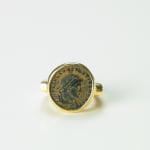Roman Bronze Coin of Emperor Constantius, 337 CE - 348 CE
Bronze
FJ.7137
Flavius Julius Constantius was born on August 7, 317 to Fausta and Constantine the Great. He became Caesar on November 8, 324 and Augustus on September 9, 337 after his...
Flavius Julius Constantius was born on August 7, 317 to Fausta and Constantine the Great. He became Caesar on November 8, 324 and Augustus on September 9, 337 after his father's death. He received the eastern provinces in the division of the Empire with his brothers Constans and Constantine II. He spent much of his reign warring with the Sassanian Empire under Sapor II, but suppressed Magnentius, the murderer of Constans, to become the sole Augustus in August of 353. He died of illness on November 3, 361 near Tarsus while marching to suppress Julian II, who had declared himself Augustus in early 360. Like his father before him, Constantius II played a prominent role in the early history of the Christian Church. He was a tolerant and just ruler, although he stifled any possible competitors to his power.
How many hands have touched a coin in your pocket or purse? What eras and lands have the coin traversed on its journey into our possession? As we reach into our pockets to pull out some change, we rarely hesitate to think of who might have touched the coin before us, or where the coin will venture to after it leaves our hands. More than money, coins are a symbol of the state that struck them, of a specific time and location, whether contemporary currencies or artifacts of a long forgotten empire. This stunning hand-struck coin reveals an expertise of craftsmanship and intricate sculptural detail that is often lacking in contemporary machine-made currencies. This ancient coin is a memorial to the Emperor Constantius II, passed from the hands of civilization to civilization, from generation to generation that still appears as vibrant today as the day it was struck.
How many hands have touched a coin in your pocket or purse? What eras and lands have the coin traversed on its journey into our possession? As we reach into our pockets to pull out some change, we rarely hesitate to think of who might have touched the coin before us, or where the coin will venture to after it leaves our hands. More than money, coins are a symbol of the state that struck them, of a specific time and location, whether contemporary currencies or artifacts of a long forgotten empire. This stunning hand-struck coin reveals an expertise of craftsmanship and intricate sculptural detail that is often lacking in contemporary machine-made currencies. This ancient coin is a memorial to the Emperor Constantius II, passed from the hands of civilization to civilization, from generation to generation that still appears as vibrant today as the day it was struck.



